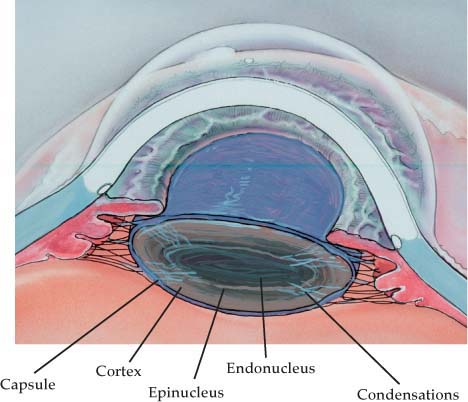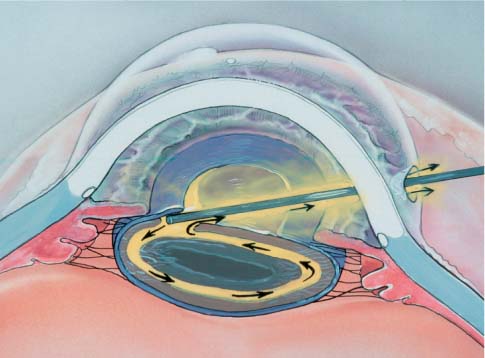Chapter 7 The hydrosteps consist of hydrodissection and hydrodelineation. Hydrodissetion is defined as the separation of cortex from adjacent cortex or from the capsular bag. It therefore is of two types—cortical cleaving and standard. Hydrodelineation is defined as the separation of the endonucleus from the epinucleus. The capsular bag is an elastic transparent basement membrane made up of type IV collagen. This basement membrane is laid down by the lens epithelial cells, which reside just inside the capsule. The zonules insert on the anterior capsule over an area 2 to 2.5 mm anterior to the equator. They insert on the posterior capsule 1 mm posterior to the equator. The capsule may be as thin as 2 to 4 μm at the posterior pole. It is thickest (17 to 23 μm) near the anterior and posterior equator where the zonular fibers attach. The anterior capsule can be as thick as 14 μm in adults.1 The posterior capsule may be particularly fragile in cases with congenital posterior lenticonus and posterior polar cataract; age-related or corticosteroid-related posterior subcapsular (PSC) cataracts involve migration and enlargement of the lens epithelial cells posteriorly where the capsule is thinnest.2 The lens is a crystalline structure with an obvious lamellar pattern containing 65% water. The 35% protein matrix is composed of soluble crystalline and insoluble albuminoid portions. It is approximately 10.5 mm in diameter and 4.5 mm thick. Anatomically it is composed of an embryonic nucleus, a fetal nucleus, an adult nucleus, and cortex. The Y sutures demarcate the fetal and adult nucleus. With age, the lens increases in size due to continuous formation of new lens fibers. This causes the older fibers to become compressed and dehydrated. Water content decreases and the lens density increases. In addition, the accumulation of brown pigment within the lens causes discoloration1 (Fig. 7–1). Surgically the adult cataractous lens can be separated into the endonucleus, epinucleus, and cortex. The endonucleus is connected to the epinucleus, cortex, and capsular bag by condensations of nuclear material, which are not evident on pathologic examination. These can be termed nuclear-capsular connections. In cortical cleaving hydrodissection a cannula is placed between the cortex and anterior capsule. The tip of a 27-gauge cannula attached to a 3-cc syringe, filled with BSS, is advanced under the anterior capsule until it is halfway between the anterior capsular rim and the capsular bag equator. The tip of the cannula is elevated until the anterior capsule is actually tented. A slow steady and firm stream of BSS is then injected. The stream of BSS will then advance anteriorally toward the anterior capsule and around the proximate equator. From there it passes behind the posterior pole of the nucleus and cortex and around to the opposite equator. It then progresses around the opposite equator emerging from the capsulorrhexis edge into the anterior chamber. Excess fluid then passes out the incision, thus relieving excessive pressure in the anterior chamber3 (Fig. 7–2A). If the nucleus floats anteriorally, a common occurrence, the surgeon should cautiously push the nucleus posteriorally. This will effectively push fluid sequestered behind the nucleus around the equator (Fig. 7–2B). The surgeon is usually able to visualize the fluid flow as a wave passing around the posterior pole and then the equator. The anterior chamber is then perceived to deepen momentarily as it fills with fluid. The anterior chamber then shallows as the fluid is seen to exit through the incision. Alternately, the nucleus floats forward stretching the capsulorrhexis. The nucleus is then pushed posteriorally with the hydrodissection cannula. The chamber deepens, and fluid and viscoelastic escape through the incision. If performed adequately, the cortex is separated or cleaved from the capsule, allowing free rotation of the endonucleus, epinucleus, and cortex as a unit, within the capsular bag. FIGURE 7–1 Surgical anatomy of the lens and zonules. Capsule is thinnest (2 to 4 μm) at the posterior pole and most thick (17 to 23 μm) at the insertion of the zonules. The nuclear-cortical-capsular bag condensations of cortex can be seen to entirely surround the nucleus. Standard hydrodissection is performed in a similar manner, except that the cannula is placed within the substance of the cortex. This produces a cleavage plane within the cortex. Consequently part of the cortex remains attached to the capsular bag and part to the endonucleus (Fig. 7–3). Cortical cleaving hydrodissection appears to have certain benefits over standard hydrodissection. First, if the cortex is cleaved from the capsular bag for 360 degrees, it is separated from the capsular bag but remains fused with the epinucleus. Therefore, the cortex is entirely removed during emulsification of the epinucleus. No irrigation and aspiration (I&A) is necessary. This eliminates the risk of ruptured posterior capsules during I&A. If the cortex is not entirely cleaved, it is usually significantly loosened from its capsular bag attachments. Hence, I&A is more easily performed. With cortical separation there is less traction on the zonules as cortex is pulled from the capsular bag during cortical aspiration. Subincisional cortex aspiration is enhanced, as it is less adherent to the capsular bag. Facilitated cortical aspiration minimizes the risk of capsular rupture during I&A. Second, less anterior segment manipulation is necessary if the capsular bag should be ruptured. This is due to the lack of need for I&A or to the necessity of minimal I&A. The risk of enlarging the tear or causing the need of increased vitrectomy is consequently decreased. FIGURE 7–2 (A) Cortical cleaving hydrodissection. The cannula elevates the anterior capsule. The fluid wave dissects cortex from the capsular bag. The nuclear-capsular bag condensations of cortex are disrupted. (B) Fluid deep to the nucleus will cause it to “float” anteriorally. Gentle pressure will displace fluid trapped behind the nucleus around the equator. Further disruption of cortex-bag connections occurs. FIGURE 7–3 Standard hydrodissection. Fluid wave passes between the epinucleus and cortex. Cortex is not cleaved from the capsular bag. The necessity for extensive irrigation and aspiration (I&A) with zonular traction is consequently necessary. Hydrodelineation is defined as the separation of the endonucleus from the epinucleus. It is generally performed immediately after hydrodissection.4 The same cannula is moved to the paracentral zone of the nucleus. It is then embedded within the nuclear substance. The cannula tip is moved forward and backward two or three times to create a track within the nuclear material. BSS is then injected slowly and firmly into the bulk of the nucleus. The BSS will find the surgical plane at the junction of the epi- and endonucleus, thus creating the separation of these two entities. During the injection of BSS the surgeon will view the fluid as it separates the endonucleus from the surrounding epinucleus, creating a “ring” around the endonucleus (Fig. 7–4
COMPLICATIONS OF THE
HYDROSTEPS: HOW TO
RECOGNIZE AND AVOID THEM
ANATOMY
HYDRODISSECTION
HYDRODELINEATION
![]()
Stay updated, free articles. Join our Telegram channel

Full access? Get Clinical Tree





